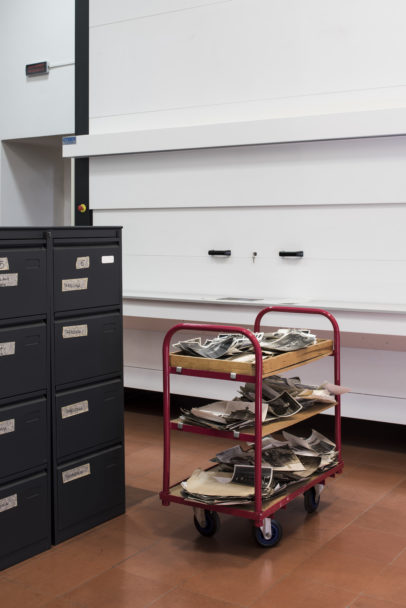Nicola Nunziata, photographer
Album, published by Fw:Books, 2019

Album is a continuation of Nicola Nunziata’s research on the materiality of photographs and the photographic objecthood; Album is an essay/research focused on to the object and subject of the medium. During a residency fellowship started mid 2017 at the Istituto Centrale del Catalogo e della Documentazione (ICCD) in Rome – one of the biggest national photography archive in Italy and part of the National Heritage Ministry – Nunziata was asked to develop a project on the 20th century photo album’s collection. His approach to the photo archive was two folded; he studied the institution’s descriptive system used for indexing and classifying the photographs – a topic of absolute relevance within the wide institutional mission of the ICCD – whilst building a studio set in the archive. Here Nunziata photographed the photo albums, selected among hundreds of them, insisting on the covers – whose composition and design reveal a wide range creativity – and on the images glued on it: he strengthened the perception of the Album as a photo object and highlighted the complex narratives. He then arranged the photographs according to new categories which he himself envisaged, building an original narrative sequences that overturns the institute’s descriptive system; in doing so Nunziata’s project Album undermines the institution’s premises and approach to photography. Nunziata then asked the book designer Hans Gremmen to intervene on his visual narrative for its publication in a book; their collaboration on this further step of the project resulted in a new Album, a layered and kaleidoscopic book which, once again, overturns Nunziata’s own narrative into something and much more complex object. So Album is the result of a collaboration aimed at subverting any given narrative, and as such stimulates an understanding of photography potentiality in adapting to discoursive contexts, from the archive to the printing process.
On which fields of knowledge are you focused?
Visual arts.
What is the object of your research?
Image making
Could you identify some constants in your work?
The materiality of photographs, photographic objecthood, images reproduction, appropriation art, material culture, experimental photography, printing and bookmaking.
How did you find out about Aby Warburg’s work? What interests you the most?
I heard about Aby Warburg as a student. If I have to think about it now, in this moment, what I found interesting but also mysterious, maybe is how deep was his relation with images.
How would you define an Atlas?
A crossing path.
Atlas as a conceptual, formal and mnemonic device; do you use it in your work?
Maybe yes, but not in a systematic way
Do you know about the existence of Mnemotechnics?
Yes
Which mnemonic system guides the organization of your material?
I call it joking: form and feeling.
Are there visual and emotional formulas (pathosformeln) in your project?
Yes
In your work, do you identify formal or conceptual recurrences such as repetitions and disruption, distance and proximity, identity and migration, conflict and colonization?
Each of my body of work is a complex system presented in order to seem a simply system. Repetitions, series, visual quotes, references and details, are in a continuous relation. Each time there is an evident topic together with a more subtle one, which is always referred to the act of image making.
In your work, what is the balance between image and text?
A mere divulgative function, until now. In my latest bookworks words are always on a separate booklet, hoping that it can be lost over time, leaving the images once and for all alone.
Thinking about Warburg’s ‘good neighborhood rule’, what are the books that underpin your project?
Luce Lebart, Taches & traces: Premiers essais photosensibles d’Hippolyte Bayard, Diaphanes Editions, 2015
Elizabeth Edwards, Photographs Objects Histories: On the Materiality of Images, Routledge, 2004
Giuliana Bruno, Superfici. A proposito di estetica, materialità e media, Johan&Levi, 2016
Nicola Nunziata, How what exists exists, Fw:Books, 2015
Douglas Eklund, The Pictures Generation, 1974-1984, Metropolitan Museum of Art, 2009
M. Danbolt, J. Rowley, L. Welters (edited by), Lost and found: queerying the archive, Nikolaj, Copenhagen CAC, 2009
Luigi Ghirri, Atlante, Edizioni Charta, 1998
Lew Thomas, Structural(ism) and photography, NFS Press, 1978
Georges Perec, Le cose, Einaudi, 2011
Franco Vimercati. Opere 1975-2001, Skira, 2011
Stan Douglas, Midcentury Studio, Ludion, 2011
Stefano Graziani, Taxonomies, A+M Bookstore, 2006
Jaya Pelupessy, Set Put Run, Fw:Books, 2015
Drew Nikonowicz, This world and other like it, Fw:Books, 2019
Nicola Nunziata (b. Naples, 1984) explores the photographic medium and the act of image making by photographing and reproducing existing printed matter, photographic material and equipment, as well as appropriating images. His works are often realised in series and conceived as books, his favourite art form.